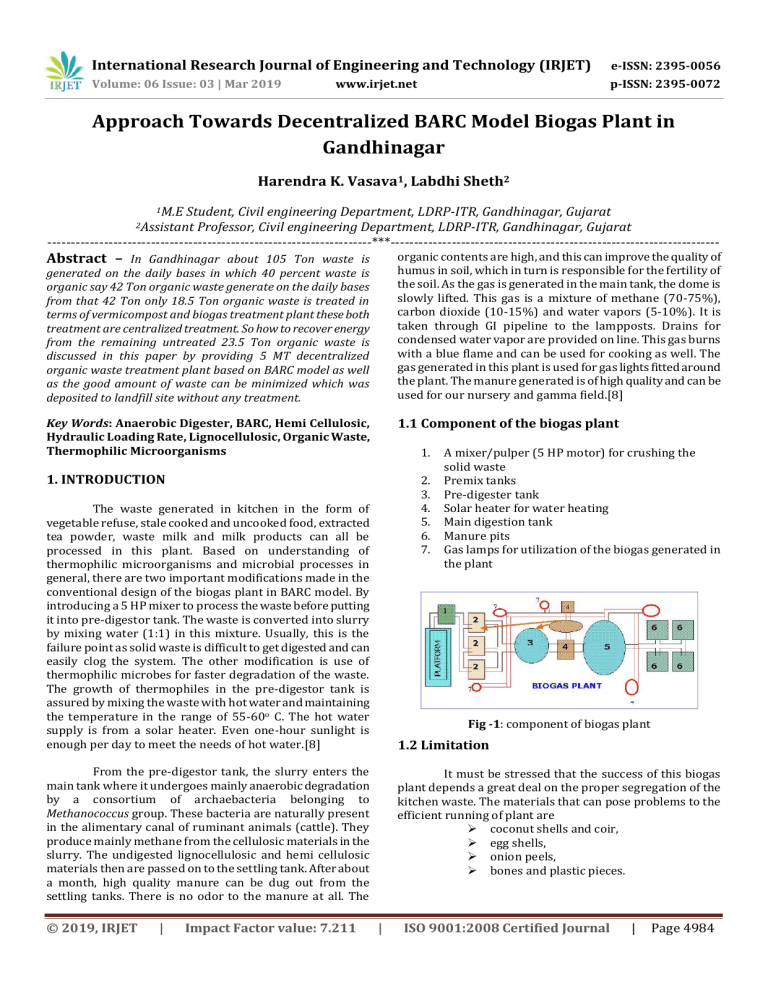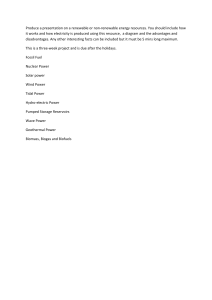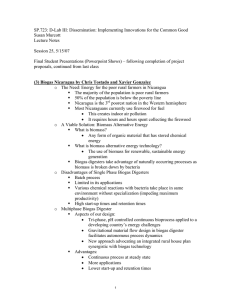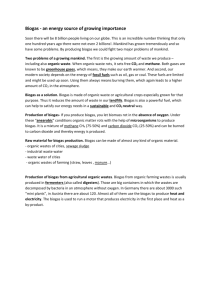IRJET- Approach Towards Decentralized BARC Model Biogas Plant in Gandhinagar
advertisement

International Research Journal of Engineering and Technology (IRJET) e-ISSN: 2395-0056 Volume: 06 Issue: 03 | Mar 2019 p-ISSN: 2395-0072 www.irjet.net Approach Towards Decentralized BARC Model Biogas Plant in Gandhinagar Harendra K. Vasava1, Labdhi Sheth2 1M.E Student, Civil engineering Department, LDRP-ITR, Gandhinagar, Gujarat Professor, Civil engineering Department, LDRP-ITR, Gandhinagar, Gujarat ---------------------------------------------------------------------***---------------------------------------------------------------------2Assistant Abstract – In Gandhinagar about 105 Ton waste is organic contents are high, and this can improve the quality of humus in soil, which in turn is responsible for the fertility of the soil. As the gas is generated in the main tank, the dome is slowly lifted. This gas is a mixture of methane (70-75%), carbon dioxide (10-15%) and water vapors (5-10%). It is taken through GI pipeline to the lampposts. Drains for condensed water vapor are provided on line. This gas burns with a blue flame and can be used for cooking as well. The gas generated in this plant is used for gas lights fitted around the plant. The manure generated is of high quality and can be used for our nursery and gamma field.[8] Key Words: Anaerobic Digester, BARC, Hemi Cellulosic, Hydraulic Loading Rate, Lignocellulosic, Organic Waste, Thermophilic Microorganisms 1.1 Component of the biogas plant generated on the daily bases in which 40 percent waste is organic say 42 Ton organic waste generate on the daily bases from that 42 Ton only 18.5 Ton organic waste is treated in terms of vermicompost and biogas treatment plant these both treatment are centralized treatment. So how to recover energy from the remaining untreated 23.5 Ton organic waste is discussed in this paper by providing 5 MT decentralized organic waste treatment plant based on BARC model as well as the good amount of waste can be minimized which was deposited to landfill site without any treatment. 1. 1. INTRODUCTION 2. 3. 4. 5. 6. 7. The waste generated in kitchen in the form of vegetable refuse, stale cooked and uncooked food, extracted tea powder, waste milk and milk products can all be processed in this plant. Based on understanding of thermophilic microorganisms and microbial processes in general, there are two important modifications made in the conventional design of the biogas plant in BARC model. By introducing a 5 HP mixer to process the waste before putting it into pre-digestor tank. The waste is converted into slurry by mixing water (1:1) in this mixture. Usually, this is the failure point as solid waste is difficult to get digested and can easily clog the system. The other modification is use of thermophilic microbes for faster degradation of the waste. The growth of thermophiles in the pre-digestor tank is assured by mixing the waste with hot water and maintaining the temperature in the range of 55-60o C. The hot water supply is from a solar heater. Even one-hour sunlight is enough per day to meet the needs of hot water.[8] Fig -1: component of biogas plant 1.2 Limitation From the pre-digestor tank, the slurry enters the main tank where it undergoes mainly anaerobic degradation by a consortium of archaebacteria belonging to Methanococcus group. These bacteria are naturally present in the alimentary canal of ruminant animals (cattle). They produce mainly methane from the cellulosic materials in the slurry. The undigested lignocellulosic and hemi cellulosic materials then are passed on to the settling tank. After about a month, high quality manure can be dug out from the settling tanks. There is no odor to the manure at all. The © 2019, IRJET | Impact Factor value: 7.211 A mixer/pulper (5 HP motor) for crushing the solid waste Premix tanks Pre-digester tank Solar heater for water heating Main digestion tank Manure pits Gas lamps for utilization of the biogas generated in the plant It must be stressed that the success of this biogas plant depends a great deal on the proper segregation of the kitchen waste. The materials that can pose problems to the efficient running of plant are coconut shells and coir, egg shells, onion peels, bones and plastic pieces. | ISO 9001:2008 Certified Journal | Page 4984 International Research Journal of Engineering and Technology (IRJET) e-ISSN: 2395-0056 Volume: 06 Issue: 03 | Mar 2019 p-ISSN: 2395-0072 www.irjet.net Steel utensils like dishes, spoons, etc. are likely to appear in the waste bags from canteens. While bones, shells and utensils can spoil the mixer physically, the onion peels, coir and plastic can have detrimental effects on microbial consortium in the pre-digester and main digestion tanks which could be disastrous for the plant. Hence, it is necessary that following precautions may be taken while collecting the kitchen waste. There should be a separate container for coconut shells, coir, egg shells, onion peels and bones. These will not be processed in the biogas plant. There should be separate containers of small volumes (5l. capacity) to collect the wet waste (spoilt or stale cooked food, waste milk products, etc.). The vegetables refuse like peels of various vegetables, rotten potatoes and tomatoes, coriander leaves, etc. may be collected in garbage bags of 5-kilo capacity. It must be noted that such segregation is of utmost importance for the smooth running of the biogas plant.[8] Chart-1: Waste Characterization in Typical Indian City (Source: State of Environment Report) According to Gujarat pollution control board (march2018) waste production in Gandhinagar city is 105 TPD [1][2] 2. STUDY AREA & DATA COLLECTION Table -1: Solid Waste Statistics along with quantities for Gandhinagar City (source: GMC) Sr. NO. Type Quantity (TPD) 1 vermi compost 16 2 Biogas 2.5 3 Recycle 20 4 C&D 10 5 Road Swipping 10 Total treated waste 58.5 Total untreated waste 46.5 Total organic waste generated per day is 40% of the total solid waste.[9] Fig -2: map of Gandhinagar city (source: google image) So, Total organic waste = 40% x 105 Local information [3] o Country: India o State: Gujarat o District: Gandhinagar o Area: 177 km2 (68 sq. mi) o Population (2011): 2,92,167 o Time zone: IST (UTC+5:30) o Coordinates: 23.2156o N, 72.6369o E = 42 TPD 3. DESIGN A BIOGAS PLANT Total waste = 5 TPD = 5000 kg Waste is converted into slurry by mixing water (1:1) in this mixture. So total weight of the waste after addition of water is 10000 kg So, daily inflow = 10000 lit/day or 10 m3/day. © 2019, IRJET | Impact Factor value: 7.211 | Volume of the digester VD = daily inflow (m3/day) x Detention Period (days) = 10 x 12 = 120 m3 ISO 9001:2008 Certified Journal | Page 4985 International Research Journal of Engineering and Technology (IRJET) e-ISSN: 2395-0056 Volume: 06 Issue: 03 | Mar 2019 p-ISSN: 2395-0072 www.irjet.net 4. CONCLUSIONS Plan area of the digester [4] Since the hydraulic loading rate (HLR) for an anaerobic digester ranges between 175 200L/day/m2 we can take the HLR as 200 L/day/m2 With the help of this BARC model biogas for the 5 TPD organic waste 30 m3 biogas can be generated. In the Gandhinagar majority number of restaurants are situated at sector 16 as well as info-city shopping complex at which good amount of kitchen waste is producing on the daily bases. On the other hand, in the sector 21, vegetable and fruit market are there producing good amount of organic waste. So, providing decentralized biogas based on BARC model for the 5 TPD organic waste at mentioned above location around 15 TPD waste is minimize which is disposed to the landfill site at sector 30. A = Daily Inflow / HLR = 10000 / 200 = 50 m2 Diameter of the digester D = Height of the digester = 7.97 m Main advantages of this decentralized system are high quality weed less and odorless manure is obtained which can be used as soil conditioner, Suitable for larger community, save on transporting of waste, Complete digestion of waste is possible & More environmentally friendly H = volume/ surface area =120/50 = 2.4 m Design of gas collecting dome The design of the gas dome depends upon the volume of gas to be evolved. Volume of the gas dome = volume of gas to be evolved REFERENCES [1] Volume of waste is 120 m3 COD of the feed = 500 mg/L [2] [3] Total COD to be digested for the evolution of the gas is = COD * volume = 500 x 120 x 1000 = 60 x 106 mg = 60000 gm. [4] [5] Now, 1g CH4 = 4g COD ~ 1.4 L CH4 [4] Thus 60000 gm. of COD will produce 21000 L of CH4 or 21 m3 CH4 Thus, required volume of the CH4 evolved can be worked out. [6] Since, biomass contains 70% (approx.) of CH4 Thus, total biogas production = volume of CH4 / 0.6 = 21/0.7 = 30 m3 [7] [8] Annual Report of Gujarat Pollution Control Board (2013-2018) By Government of Gujarat Data from Gandhinagar Municipal corporation http://www.gandhinagarmunicipal.com/Departme nts/page/Solid%20Waste%20Management Ingole Nitin W, “Development and Design of Biogas Plant for Treatment of Kitchen Waste” International Journal of Research in Engineering, Science And Technology/Vol.1/Issue 05, August 2015.[3] M. Samer (2012). Biogas Plant Constructions, Biogas, Dr. Sunil Kumar (Ed.), ISBN:978-953-510204-5,Intech, AvailableFrom:Http://Www.Intechopen.Com/Book s/Biogas/Biogas-Plant-Constructions Municipal Solid Waste Management Manual 2016 (vol. 2) By Central Public Health and Environmental Engineering Organization (CPHEEO), Government of India State of Environment Report Gujarat (2012,2017) By Forest & Environment Department, Government of Gujarat S. P. Kale and S. T. Mehetre, “Biogas Plant Based on Kitchen Waste” Thus, volume of gas dome = total biogas production of the day Height of gas dome = volume of gas dome / area of the digester = 30/50 = 0.6 m © 2019, IRJET | Impact Factor value: 7.211 | ISO 9001:2008 Certified Journal | Page 4986




